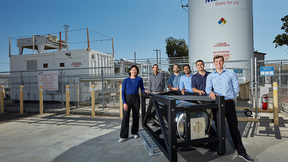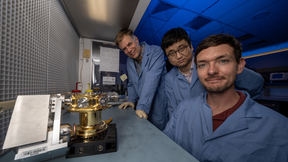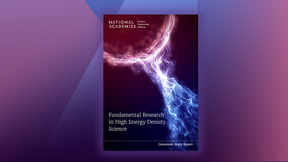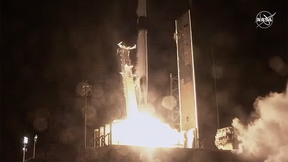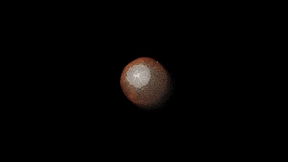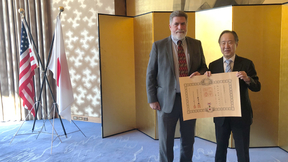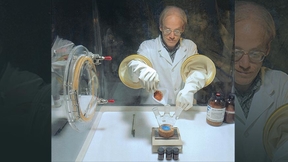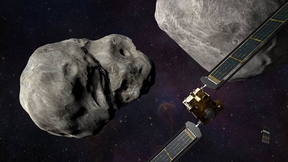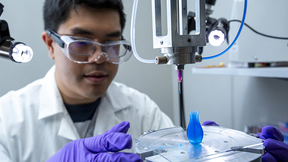Back
Lawrence Livermore National Laboratory’s (LLNL) Pandora SmallSat mission recently passed NASA’s critical design review: a major milestone for the mission to continue its journey toward launch. The Pandora SmallSat mission will study planets beyond our solar system, known as exoplanets, and their stars. “This is a major milestone for the mission and a huge accomplishment…
Lawrence Livermore National Laboratory (LLNL) and Verne, a San Francisco-based startup, have demonstrated a cryo-compressed hydrogen storage system of suitable scale for heavy-duty vehicles. This is the first time cryo-compressed hydrogen storage has been demonstrated at a scale large enough to be useful for semi trucks, a milestone in high-density hydrogen storage…
Lawrence Livermore National Laboratory (LLNL) researchers, along with scientists from more than a dozen institutions, have completed a first-of-its-kind high-resolution assessment of carbon dioxide (CO2) removal (CDR) in the United States. The report, “Roads to Removal: Options for Carbon Dioxide Removal in the United States,” charts a path for the United States to achieve…
Lawrence Livermore National Laboratory subject matter experts (SMEs) have been selected by the United States Space Force to help stand up its newest Tools, Applications and Processing (TAP) laboratory dedicated to advancing military space domain awareness (SDA). The LLNL team attended the Oct. 26 kick-off in Colorado Springs of the SDA TAP lab’s Project Apollo technology…
An instrument designed and built by Lawrence Livermore National Laboratory (LLNL) researchers departed Earth last week on a two-billion-mile, nearly six-year journey through space to explore a rare, largely metal asteroid. The Livermore high-purity germanium (HPGe) gamma-ray sensor is an essential part of a larger gamma-ray spectrometer (GRS) built in collaboration with…
When SpaceX’s Dragon spacecraft docked with the International Space Station (ISS) on March 16, it delivered several thousand pounds of supplies for the crew as well as new hardware. The hardware included the U.S. Space Force’s Space Test Program Houston 9 (STP-H9) platform, which houses a prototype telescope designed and built by Lawrence Livermore National Laboratory's…
The National Academies of Sciences, Engineering, and Medicine released a report, Fundamental Research in High Energy Density Science, which identifies key challenges and science questions for the field of High Energy Density (HED) science for the coming decade and proposes ways to address them. The report follows a year-and-a-half-long consensus study by a committee of 13…
A prototype telescope designed and built by Lawrence Livermore National Laboratory (LLNL) researchers has been launched from Cape Canaveral, Fla., to the International Space Station (ISS). Known as the Stellar Occultation Hypertemporal Imaging Payload (SOHIP), the telescope uses LLNL patented-monolithic optics technology on a gimbal to observe and measure atmospheric…
On the morning of Feb. 15, 2013, a small asteroid exploded over Chelyabinsk, Russia, sending a loud shockwave and sonic boom across the region, damaging buildings and leaving around 1,200 people injured. The resulting meteor, with a diameter of approximate 20 meters (roughly the size of a six-story building), was one of the largest to be detected breaking up in the Earth’s…
A new software developed at Lawrence Livermore National Laboratory (LLNL), and known as Skywing, provides domain scientists working to protect the nation’s critical infrastructure with a high-reliability, real-time software platform for collaborative autonomy applications. The U.S. modern critical infrastructure — from the electrical grid that sends power to homes to the…
Brad Roberts has received one of the highest honors bestowed by the Government of Japan. The director of the Center for Global Security Research (CGSR) at Lawrence Livermore National Laboratory (LLNL), Roberts has been given the Order of the Rising Sun, an honor awarded by the prime minister of Japan to people who have rendered distinguished service to the nation. The…
A team of Lawrence Livermore National Laboratory (LLNL) scientists has developed a new technique to analyze fentanyl in human blood and urine samples that could aid work in the fields of medicine and chemical forensics. Led by Carlos Valdez, an LLNL synthetic chemist and lead author, the team discussed its new fentanyl analysis approach in a paper recently published in the…
Immune responses could be supported by drugs to help people recover from brain infections caused by Rift Valley fever virus Research by Lawrence Livermore National Laboratory (LLNL) scientists suggests that immune responses could be bolstered by drugs to help people recover from brain infections caused by an emerging pathogen. The emerging pathogen studied by the team,…
A five-year microbial study of the International Space Station (ISS) and its astronauts by Lawrence Livermore National Laboratory (LLNL) and NASA researchers has found that the ISS habitat is safe for its residents. The research effort represents the first comprehensive characterization of the space station’s environmental profile (or microbiome) and is the first to…
It was a scene right out of the movies. NASA’s DART spacecraft successfully impacted its asteroid target in the world’s first planetary defense technology demonstration at 4:14 p.m. (PDT) on Sept. 26. Two weeks after impact, NASA has confirmed the mission changed the asteroid’s motion in space. “We were anxiously awaiting the spacecraft’s final hours with the DART…
The last nuclear test, code-named Divider, took place 30 years ago, on Sept. 23, 1992. That year, President Bush declared a temporary moratorium on nuclear testing, which became permanent during the Clinton administration. This ending of the era of nuclear testing was also the beginning of stockpile stewardship. Leaders from the Department of Energy (DOE), and Lawrence…
Scientific discovery during the Stockpile Stewardship Program maintains confidence in the nuclear deterrent without testing, brings other benefits The last nuclear test, code-named Divider, took place 30 years ago, on September 23, 1992. That year, President Bush declared a temporary moratorium on nuclear testing, which became permanent during the Clinton administration…
The last nuclear test, code-named Divider, took place 30 years ago, on Sept. 23, 1992. That year, President Bush declared a temporary moratorium on nuclear testing, which became permanent in 1995, during the Clinton administration. This ending of the era of nuclear testing coincided with a Presidential announcement of the beginning of stockpile stewardship. As the decision…
Today at 4:14 p.m. (PDT), NASA’s Double Asteroid Redirection Test (DART) Mission will execute the first-ever asteroid-deflection test by crashing into asteroid Dimorphos. Traveling at ~6 km/s with a mass of ~600 kg, the DART spacecraft will transfer enough momentum for the imparted change in velocity to be detectable from Earth-based telescopes. However, there is…
Lawrence Livermore National Laboratory (LLNL) scientists and engineers have garnered three awards among the top 100 industrial inventions worldwide. The trade journal R&D World Magazine recently announced the winners of the awards, often called the “Oscars of invention,” recognizing new commercial products, technologies and materials that are available for sale or…


